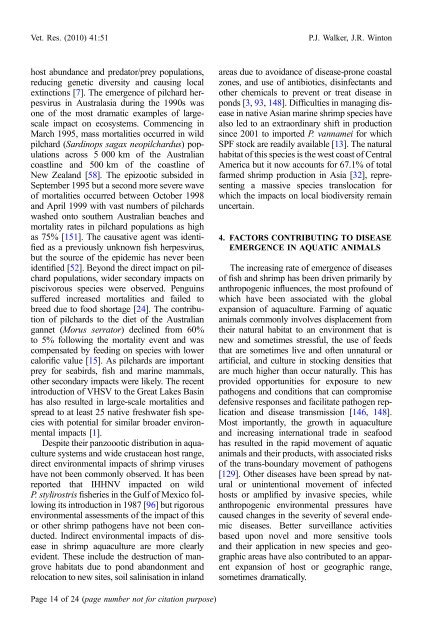Emerging viral diseases of fish and shrimp - Watershed Watch ...
Emerging viral diseases of fish and shrimp - Watershed Watch ...
Emerging viral diseases of fish and shrimp - Watershed Watch ...
Create successful ePaper yourself
Turn your PDF publications into a flip-book with our unique Google optimized e-Paper software.
Vet. Res. (2010) 41:51<br />
P.J. Walker, J.R. Winton<br />
host abundance <strong>and</strong> predator/prey populations,<br />
reducing genetic diversity <strong>and</strong> causing local<br />
extinctions [7]. The emergence <strong>of</strong> pilchard herpesvirus<br />
in Australasia during the 1990s was<br />
one <strong>of</strong> the most dramatic examples <strong>of</strong> largescale<br />
impact on ecosystems. Commencing in<br />
March 1995, mass mortalities occurred in wild<br />
pilchard (Sardinops sagax neopilchardus) populations<br />
across 5 000 km <strong>of</strong> the Australian<br />
coastline <strong>and</strong> 500 km <strong>of</strong> the coastline <strong>of</strong><br />
New Zeal<strong>and</strong> [58]. The epizootic subsided in<br />
September 1995 but a second more severe wave<br />
<strong>of</strong> mortalities occurred between October 1998<br />
<strong>and</strong> April 1999 with vast numbers <strong>of</strong> pilchards<br />
washed onto southern Australian beaches <strong>and</strong><br />
mortality rates in pilchard populations as high<br />
as 75% [151]. The causative agent was identified<br />
as a previously unknown <strong>fish</strong> herpesvirus,<br />
but the source <strong>of</strong> the epidemic has never been<br />
identified [52]. Beyond the direct impact on pilchard<br />
populations, wider secondary impacts on<br />
piscivorous species were observed. Penguins<br />
suffered increased mortalities <strong>and</strong> failed to<br />
breed due to food shortage [24]. The contribution<br />
<strong>of</strong> pilchards to the diet <strong>of</strong> the Australian<br />
gannet (Morus serrator) declined from 60%<br />
to 5% following the mortality event <strong>and</strong> was<br />
compensated by feeding on species with lower<br />
calorific value [15]. As pilchards are important<br />
prey for seabirds, <strong>fish</strong> <strong>and</strong> marine mammals,<br />
other secondary impacts were likely. The recent<br />
introduction <strong>of</strong> VHSV to the Great Lakes Basin<br />
has also resulted in large-scale mortalities <strong>and</strong><br />
spread to at least 25 native freshwater <strong>fish</strong> species<br />
with potential for similar broader environmental<br />
impacts [1].<br />
Despite their panzoootic distribution in aquaculture<br />
systems <strong>and</strong> wide crustacean host range,<br />
direct environmental impacts <strong>of</strong> <strong>shrimp</strong> viruses<br />
have not been commonly observed. It has been<br />
reported that IHHNV impacted on wild<br />
P. stylirostris <strong>fish</strong>eries in the Gulf <strong>of</strong> Mexico following<br />
its introduction in 1987 [96]butrigorous<br />
environmental assessments <strong>of</strong> the impact <strong>of</strong> this<br />
or other <strong>shrimp</strong> pathogens have not been conducted.<br />
Indirect environmental impacts <strong>of</strong> disease<br />
in <strong>shrimp</strong> aquaculture are more clearly<br />
evident. These include the destruction <strong>of</strong> mangrove<br />
habitats due to pond ab<strong>and</strong>onment <strong>and</strong><br />
relocation to new sites, soil salinisation in inl<strong>and</strong><br />
areas due to avoidance <strong>of</strong> disease-prone coastal<br />
zones, <strong>and</strong> use <strong>of</strong> antibiotics, disinfectants <strong>and</strong><br />
other chemicals to prevent or treat disease in<br />
ponds [3, 93, 148]. Difficulties in managing disease<br />
in native Asian marine <strong>shrimp</strong> species have<br />
also led to an extraordinary shift in production<br />
since 2001 to imported P. vannamei for which<br />
SPF stock are readily available [13]. The natural<br />
habitat <strong>of</strong> this species is the west coast <strong>of</strong> Central<br />
America but it now accounts for 67.1% <strong>of</strong> total<br />
farmed <strong>shrimp</strong> production in Asia [32], representing<br />
a massive species translocation for<br />
which the impacts on local biodiversity remain<br />
uncertain.<br />
4. FACTORS CONTRIBUTING TO DISEASE<br />
EMERGENCE IN AQUATIC ANIMALS<br />
The increasing rate <strong>of</strong> emergence <strong>of</strong> <strong>diseases</strong><br />
<strong>of</strong> <strong>fish</strong> <strong>and</strong> <strong>shrimp</strong> has been driven primarily by<br />
anthropogenic influences, the most pr<strong>of</strong>ound <strong>of</strong><br />
which have been associated with the global<br />
expansion <strong>of</strong> aquaculture. Farming <strong>of</strong> aquatic<br />
animals commonly involves displacement from<br />
their natural habitat to an environment that is<br />
new <strong>and</strong> sometimes stressful, the use <strong>of</strong> feeds<br />
that are sometimes live <strong>and</strong> <strong>of</strong>ten unnatural or<br />
artificial, <strong>and</strong> culture in stocking densities that<br />
are much higher than occur naturally. This has<br />
provided opportunities for exposure to new<br />
pathogens <strong>and</strong> conditions that can compromise<br />
defensive responses <strong>and</strong> facilitate pathogen replication<br />
<strong>and</strong> disease transmission [146, 148].<br />
Most importantly, the growth in aquaculture<br />
<strong>and</strong> increasing international trade in seafood<br />
has resulted in the rapid movement <strong>of</strong> aquatic<br />
animals <strong>and</strong> their products, with associated risks<br />
<strong>of</strong> the trans-boundary movement <strong>of</strong> pathogens<br />
[129]. Other <strong>diseases</strong> have been spread by natural<br />
or unintentional movement <strong>of</strong> infected<br />
hosts or amplified by invasive species, while<br />
anthropogenic environmental pressures have<br />
caused changes in the severity <strong>of</strong> several endemic<br />
<strong>diseases</strong>. Better surveillance activities<br />
based upon novel <strong>and</strong> more sensitive tools<br />
<strong>and</strong> their application in new species <strong>and</strong> geographic<br />
areas have also contributed to an apparent<br />
expansion <strong>of</strong> host or geographic range,<br />
sometimes dramatically.<br />
Page 14 <strong>of</strong> 24 (page number not for citation purpose)
















